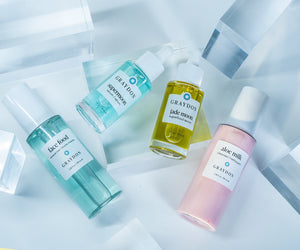Aging is a privilege—and one I embrace fully. Still, that doesn’t mean every visible reminder of aging fills me with joy. Like many women, I’ve had moments standing in front of a mirror, pulling at the skin above my knees or scrutinizing the crepey skin on my calves. I’ve caught myself saying things like, “Don’t post that picture of me in shorts,” or feeling like I should wear pantyhose under cropped pants to hide the texture on my legs.
But here’s the truth: confidence and age positivity don’t require perfection. You can love your body, respect the aging process, and still want to feel good about the skin you're in.
If crepey legs—or just crepey skin in general—is stopping you from wearing shorts or sleeveless tops in the summer, or from showing off your beautiful skin, here’s some knowledge on what crepey skin really is, what causes it, and most importantly, what you can do to care for it.
What Is Crepey Skin?
“Crepey” is a term we often hear in skincare conversations, but what does it actually mean?
Think of crepey skin like tissue paper—thin, crinkled, and fragile. Unlike plump skin, crepey skin is marked by a combination of dryness, fine lines, and a lack of firmness. It often feels loose or saggy, and while it can sometimes resemble wrinkles, it’s not quite the same. Wrinkles are usually deeper and more defined, whereas crepey skin has that signature fragile, crinkled texture—like party streamers after a celebration.
The most common culprit? Aging. As we age, our skin produces less oil, making it drier and more prone to that papery texture. But aging is only part of the story.
Crepey Skin on the Legs
The reason I wanted to talk about crepey skin specifically on the legs is because it’s also an area where a number of other things like cellulite, spider veins, and stretch marks are commonly visible.

This is not to say that these are bad or undesirable, but that I understand the legs can be a pretty common area to feel self-conscious about—I know I sometimes am.
But crepey skin doesn’t just show up on your legs. Actually, it can appear anywhere on the body. Thinner skin is more susceptible to developing that crepey texture, and since our skin thins as we age, we can see it showing up in common areas like the neck, chest, eyelids, under the eyes, arms, and tops of the hands. Sun damage can speed up the development of crepey skin, so you’ll notice that all of the places I’ve listed are areas of your body that are also most exposed to the sun.
I already gave away two big ones when it comes to what causes crepey skin—aging and sun damage—but let’s dive deeper into some of the causes.
What Causes Crepey Skin?
Crepey skin is the result of a mix of internal and external factors. Here’s a breakdown of the most common ones:
Sun Damage
One of the leading causes of crepey skin is UV exposure. Sun damage breaks down collagen and elastin—proteins that keep your skin firm, plump, and resilient. Without them, skin becomes thinner, more fragile, and more prone to sagging and wrinkling.
Aging
As mentioned, aging naturally slows oil production, which contributes to dryness and reduced elasticity. Our collagen and elastin production also naturally slow as we age. The skin also becomes thinner over time, particularly in areas with less fat or muscle underneath to provide structure.
Weight Fluctuations
Significant weight gain or loss can stretch the skin and, over time, affect its ability to bounce back. This can result in sagging and a crepey appearance, especially on the arms, stomach, and thighs. The bodily—and hormonal—changes you go through while pregnant can cause a similar effect.
Lifestyle Factors
Poor nutrition, lack of exercise, smoking, and dehydration all play a role in how your skin ages. A lack of movement and circulation can impact skin health, and nutrient deficiencies can leave skin looking dull and lifeless. Meals rich in vitamins, healthy fats, fibre, and protein like this recipe or this one can support your skin health.
Solutions and Preventions for Crepey Skin

We all deserve to look and feel good in our skin. The good news is that caring for your skin doesn’t have to be complicated. In fact, most of the time what your skin needs is simply some hydration and protection.
Moisturize Your Skin
Most of the time, things like fine lines and crepey skin can be visibly improved just by applying some moisturizer or a body oil to the skin. Why? Well, when the skin is properly hydrated and moisturized, it becomes plump and fuller looking, meaning some sagging and lines are “filled in”. It’s considered a temporary benefit, which is why I use the words “visibly improved” because it’s at the visual level, because skin can become dehydrated again. The solution? A consistent moisturizing routine so your skin stays soft and supple.

There are also so many moisturizing ingredients that offer additional benefits that can help with crepey skin. Cocoa butter (used in Berry Rich), for example, also helps improve skin elasticity. Jojoba oil, used in our All Over Face + Body Lotion, is anti-inflammatory and protective against additional skin damage. Squalane, found in our Intimacy Oil, offers antioxidant and soothing benefits.
Gently Exfoliate
Exfoliation helps remove the dead skin cells that cause that dull, textured look we all sometimes get. We want those new, fresh skin cells our body has diligently created during the skin cycle to have their moment—after all, these new skin cells are smoother and brighter!
There’s a few ways to exfoliate. You can do it manually with anything from a physical scrub, to a washcloth or exfoliating sponge, to something like dry brushing. You can also use a chemical exfoliant. This is when the ingredient itself is exfoliating your skin rather than physically “scrubbing”. Chemical exfoliants do this through softening some of the “glue” that holds your dead skin cells together, allowing them to slough off.
We use exfoliating willow bark extract in Face Foam, our foaming facial cleanser. But for the body, I’d actually recommend mixing drops of an exfoliating acid into your body lotion when you apply it!
Wear SPF Vigilantly
I shared earlier that UV damage is one of the biggest culprits when it comes to crepey skin. Getting too much sun can cause free radical damage, inflammation (especially when you get sunburns!), collagen and elastin breakdown, and more. This translates into skin that is not as firm, smooth, and plump as it could be had you been using SPF.

Now, as much as I’d like to, I can’t undo those years of treating sunscreen as a suggestion more than a necessity. If you have a similar story, it can be easy to tell yourself “it’s too late now.” But, I’ll counter that damage protection always matters.
Even if you can’t undo the sun damage your skin has received throughout your life, you can make sure that you’re not sabotaging any creams or oils you’re using now to improve the appearance of crepey skin.
Think about it that way—why undo all the hard work your skincare is doing by not also using SPF?
Protect Your Skin with Antioxidants
Antioxidants are the best way to protect your skin from free radical damage, which can age the skin and cause crepey texture over time. The good news is that antioxidants are abundant in skincare. In fact, there’s probably at least one antioxidant in the serum or moisturizer you have on your bathroom counter (though it’s always smart to check).
Did you know all of these popular skincare ingredients are antioxidants?
We also use a ton of plant-based antioxidants in our body care products because they are so protective, like the milk thistle and olive-derived squalane in Intimacy Oil, and the rosemary in All Over Face + Body Lotion.
Antioxidant protection alone shouldn’t be the only thing in your body care routine, though. Think of it as a supplement to moisturization and exfoliation!
Add Some Glow to Your Legs
A good body care routine can give you some great results when used consistently—and when the skin is dry, moisturizing can make a visible difference right away!

But some temporary glow + blur with the help of an additional skincare product can also give your legs that instantly healthy look you want.
Some people will use self tanner or maybe try a body oil with some shimmer to it to make the legs pop. My personal favourite, though, is mixing a few pumps of Face Glow into my body lotion.
Face Glow has a blurring effect to it that my skin loves, plus it adds a slight tint and subtle radiance wherever you apply it. It’s the secret to a great no makeup “makeup” look on the face, and it looks natural and flattering on the legs, chest, and arms, too.
And, if you read the section right above this one, you’ll be happy to know that Face Glow also offers some antioxidant protection thanks to the raspberry, sea buckthorn, pumpkin seed, and spirulina in the formula.
Rock Your Summer Shorts with Confidence
Crepey skin isn’t a flaw. It’s simply a part of the story our bodies tell as we age. It doesn’t make your legs any less beautiful, your arms any less strong, or your skin any less worthy of being seen.
But if crepey skin is something that’s affecting your confidence, there are ways to support your skin that feel good and empowering—not like a punishment or pressure to "fix" yourself.
I’m still learning to quiet that inner voice that tells me to cover up. But more often these days, I’m choosing the shorts. I’m choosing the dress. I’m choosing to treat my skin with love—not just through skincare, but through self-compassion and acceptance.
You deserve to feel confident in your skin—at every age, in every season, and no matter what your legs look like.
And when in doubt? Moisturize, wear SPF, and put on the damn shorts!



